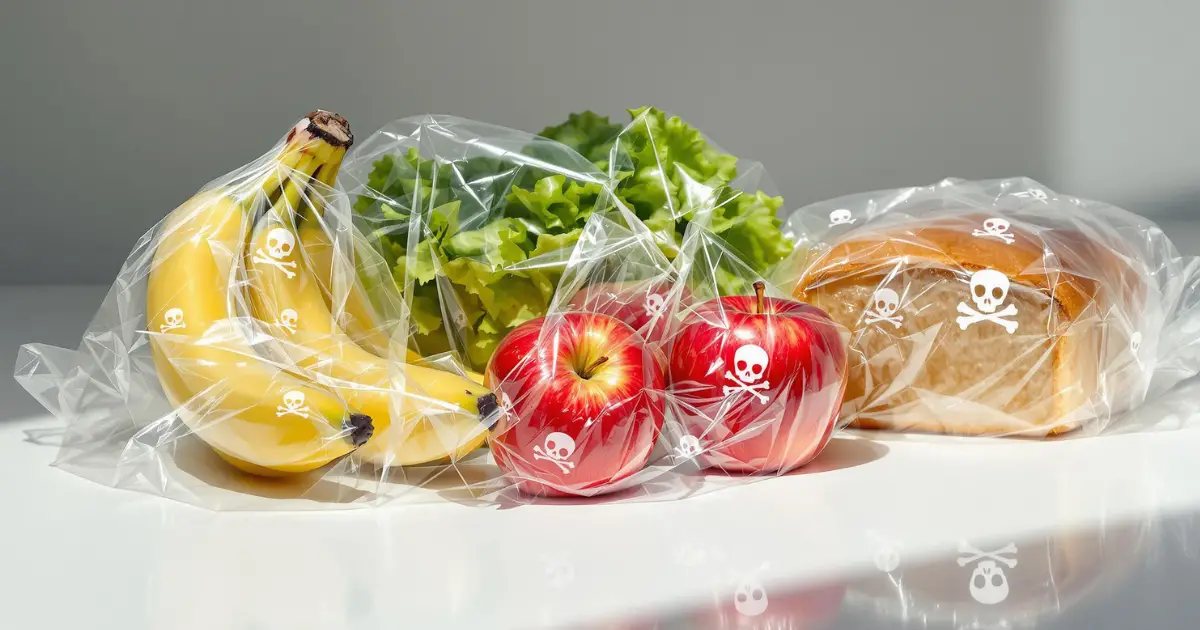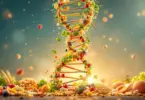December 2nd, 2024
Contributing writer for Wake Up World
Packaging is an important part of keeping your favorite cooking ingredients and meals fresh. However, a concerning amount of them are wrapped in plastic and other materials that most people take for granted. Have you ever wondered what chemicals they’re made from, and whether they’re truly safe to use for food storage?
In a meta-analysis1 published in Frontiers in Toxicology, researchers analyzed many of the chemicals that make up food packaging. They discovered an alarming revelation — hundreds of these chemicals are linked to an increased risk of breast cancer.
Nearly 200 Mammary Carcinogens Found in Food Packaging
In September 2024, researchers sought to find out just how many chemicals are lurking in food contact materials (FCMs) that are linked to breast cancer. Their goal was to create “a recent picture of likely human exposure to potential mammary carcinogens from FCMs via food ingestion.”2
The researchers chose this topic because “breast cancer is the most frequently diagnosed cancer and the globally leading cause of cancer deaths.” Moreover, they noted that there are existing discrepancies in regulations regarding the use of carcinogens in food packaging. And despite these ratified regulations, toxic chemicals are still being used.3
To conduct their analysis, the team used established databases from previous studies with existing CASRNs (Chemical Abstracts Service Registry Numbers), a system that codifies a chemical substance to its own unique ID.4 Using the CASRNs, they were able to identify the chemicals used in food packaging that are also linked to breast cancer, of which there are 189. The researchers break down their summary:5
“Thirty of the chemicals have direct evidence of carcinogenesis in rodent models, another 67 are suspected to induce carcinogenesis based on their genotoxicity, and the remainder are highly likely or likely to be endocrine disruptors.”
While the results are an eye-opener, that’s not the complete picture. According to study co-author Lindsey Parkinson, she wasn’t surprised that many chemicals are used in the manufacturing of FCMs. But she highlighted one point that got her attention:6
“What I did find surprising,” Parkinson said, “was that out of the 189 potential mammary carcinogens that have ever been detected in food contact materials, 121 — nearly two-thirds — were detected through migration studies.”
For context, migration studies refer to previously published papers that showed chemicals “known to migrate into foods with which they make contact.” This means that aside from existing in the packaging, 121 of the detected chemicals leak into the food!7 The study did have a positive discovery — glass didn’t contain any toxic chemicals:8
“Overall, 143 potential mammary carcinogens have been detected in plastic FCAs (76%), followed by non-specified materials (91; 48%), and paper and board (89; 47%), but all material groups except glass contained potential mammary carcinogens.”
Paper and Cardboard Packaging Are Also Unsafe
In an interview with CNN Health,9 study co-author Jane Muncke noted that paper and cardboard FCMs also contain chemicals linked to breast cancer. “Paper has additives such as emulsifiers and adhesives, say if papers are glued together, or there’s a plastic layer glued to the paper,” Muncke said. Just how many chemicals? The team discovered 89 potential breast carcinogens these packaging materials.10
Overall, the study points out just how outdated our policies are when it comes to controlling the presence of these cancer-causing chemicals in FCMs. For example, the researchers singled out styrene, which is a toxic chemical still used in food packaging today, despite having a shocking four decades of evidence of migration into foods. Aside from being a potential mammary carcinogen, it’s also classified as a “suspected reproductive toxicant” by the European Union since 2012.11
So, given all these chemicals embedded in FCMs, what’s the best alternative? Concluding the study, the authors noted that the best way to reduce exposure to these chemicals is to advocate policies to enforce their removal. “Getting rid of these known or suspected carcinogens in our food supply is a huge opportunity for cancer prevention,” Muncke said.12 And one way to do this is by increasing collaborations between international scientific organizations. The researchers concluded:13
“Additionally, fostering international collaboration and harmonization of regulatory standards could further strengthen global efforts to manage the risks associated with chemical migration from FCMs.
Such proactive measures are crucial in navigating the complexities of the modern food supply chain and ensuring the safety and wellbeing of consumers worldwide — today and for future generations.”
Microplastics Raise Your Estrogen Levels, Leading to Cancer
As noted in my Biohacking 2024 speech, endocrine-disrupting chemicals (EDCs) are one of the most prominent poisons that destroy your mitochondrial function, with linoleic acid and electromagnetic field (EMF) exposure being the other two. And what are the biggest sources of these endocrine disruptors? Plastics.
Plastics are xenoestrogens that mimic the effects of estrogen in the body. As explained in a study published in Life Sciences, “Chemical constituents of MPs (microplastics) like bisphenol A (BPA) act as endocrine disruptors and mimic estrogen hormones that could fuel breast cancer in females.”14
Other research has shown that microplastics contain phthalates that leach out of the material,15 leading to endocrine-disrupting effects. Other well-known culprits include per- and polyfluoroalkyl chemicals (PFAS) and pesticides.16 Xenoestrogens in plastics also damage your body in general. As summarized in the Life Sciences study:17
“These environmental contaminants modulate the epigenetic control of gene expression, status of inflammatory mediators, redox homeostasis, cell-cycle proteins and mimic the endocrine mediators like estrogen and androgen to fuel carcinogenesis. Furthermore, epidemiological studies have suggested potential links between the exposure to microplastics and the onset of various chronic diseases.
Microplastics trigger uncontrolled cell proliferation and ensue tissue growth leading to various cancers affecting the lungs, blood, breasts, prostate and ovaries. Additionally, such contamination can potentially affect sub-cellular signaling and injure multiple organs.”
Again, our exposure to plastic appears to be the top culprit. Going back to the Frontiers in Toxicology study, the researchers noted that plastics have the highest presence of potential breast carcinogens in FCMs — 76%, or 143 chemicals, to be exact.18
The First Step to Reducing Exposure — Choose Safe Food Packaging
You’ll be able to protect yourself and your family from the harmful effects of plastics by avoiding them sources as much as possible. And based on the findings, using glass containers is the ideal way of storing your food.19
In an interview with The Defender, Parkinson noted that steel and ceramic containers are also safe because they’re inert materials. Also, wait for food to cool before storing them (to avoid materials from leaching out) and buy products in bulk to minimize plastic packaging.20 Here are other strategies I recommend adopting into your everyday routine to minimize exposure to these chemicals:
| Avoid food sold in plastic containers and plastic wrap. If you currently have food in plastic containers, store them in glass containers instead. |
| Read labels looking for PVC-free products, including children’s lunch boxes, backpacks and storage containers. |
| Eat mostly fresh, whole foods. Plastic food packaging is often a source of phthalates. |
| Use glass baby bottles instead of plastic. Breastfeed exclusively for the first year, if you can, to avoid plastic nipples and baby bottles altogether. |
| Use non-plastic reusable shopping bags for your groceries. |
| Consider switching to bamboo toothbrushes and brushing your teeth with coconut oil and baking soda to avoid plastic toothpaste tubes and toothbrushes. |
| Remove your fruit and vegetables from plastic bags immediately after coming home from the grocery store and wash them before storing them; alternatively, use cloth bags to bring home your produce. |
| Bring drinking water from home in glass water bottles instead of buying bottled water. |
| Take your own non-plastic leftover container to restaurants. Avoid disposable, plastic utensils and straws. |
| Do not microwave food in plastic containers or covered in plastic wrap. |
Additional Strategies to Lower Your Exposure to Plastics
Minimizing exposure to plastic food packaging is just one way of protecting yourself. According to research,21 microplastics enter your body through other routes as well, such as your dermal and nasal pathways. This means that you need to be aware of other plastic products you use at home that contain potential carcinogens, and by extension, other household products.
If you have children, I recommend getting rid of their plastic toys. Instead, use toys made from safe, sustainable materials. In a similar vein, take stock of other products in your house such as cosmetics and cleaning products. Read the product label and get rid of those containing phthalates, replacing them with natural alternatives. For feminine care products, the same logic also applies.
Your house is also littered with products such as vinyl blinds, wallpaper, flooring and other furniture that contains phthalates. Dust that settles in these items become contaminated and are easily ingested by children, so make sure you clean them regularly. Other items in your house, such as air fresheners with “fragrances,” also contain phthalates that are used to extend shelf life — remove these, too.
Outside of your home, you’re also exposed to other endocrine-disrupting chemicals, such as BPA, commonly at cash registers that give out receipts via heat-printing. When given this kind of material, handle it as little as possible and recommend the business to switch to BPA-free receipts.
If possible, convince the business owner to adopt paperless receipts. According to the Minnesota Pollution Control Agency, one business that switched to a paperless system not only protected the employees from BPA exposure, but also saved 43 pounds of paper waste in the first six months of implementation.22
In cases of estrogen dominance, supplemental progesterone is often helpful. Progesterone is a natural estrogen antagonist and will counteract the adverse effects of excess estrogen. It’s one of four hormones I believe many adult men and women can benefit from. In the next section, I’ll go into detail how to administer progesterone properly.
How to Use Progesterone
Before you consider using progesterone, it is important to understand that it is not a magic bullet, and that you get the most benefit by implementing a Bioenergetic diet approach that allows you to effectively burn glucose as your primary fuel without backing up electrons in your mitochondria that reduces your energy production. My new book, “Your Guide to Cellular Health: Unlocking the Science of Longevity and Joy,” covers this process in great detail.
Once you have dialed in your diet, an effective strategy that can help counteract estrogen excess is to take transmucosal progesterone (i.e., applied to your gums, not oral or transdermal), which is a natural estrogen antagonist. Progesterone is one of only four hormones I believe many adults can benefit from. (The other three are thyroid hormone T3, DHEA and pregnenolone.)
I do not recommend transdermal progesterone, as your skin expresses high levels of 5-alpha reductase enzyme, which causes a significant portion of the progesterone you’re taking to be irreversibly converted primarily into allopregnanolone and cannot be converted back into progesterone.
Ideal Way to Administer Progesterone
Please note that when progesterone is used transmucosally on your gums as I advise, the FDA believes that somehow converts it into a drug and prohibits any company from advising that on its label. This is why companies like Health Natura promotes their progesterone products as “topical.”
However, please understand that it is perfectly legal for any physician to recommend an off-label indication for a drug to their patient. In this case, progesterone is a natural hormone and not a drug and is very safe even in high doses. This is unlike synthetic progesterone called progestins that are used by drug companies, but frequently, and incorrectly, referred.
Dr. Ray Peat has done the seminal work in progesterone and probably was the world’s greatest expert on progesterone. He wrote his Ph.D. on estrogen in 1982 and spent most of his professional career documenting the need to counteract the dangers of excess estrogen with low LA diets and transmucosal progesterone supplementation.
He determined that most solvents do not dissolve progesterone well and discovered that vitamin E is the best solvent to optimally provide progesterone in your tissue. Vitamin E also protects you against damage from LA. You just need to be very careful about which vitamin E you use as most supplemental vitamin E on the market is worse than worthless and will cause you harm not benefit.
It is imperative to avoid using any synthetic vitamin E (alpha tocopherol acetate — the acetate indicates that it’s synthetic). Natural vitamin E will be labeled “d alpha tocopherol.” This is the pure D isomer, which is what your body can use.
There are also other vitamin E isomers, and you want the complete spectrum of tocopherols and tocotrienols, specifically the beta, gamma, and delta types, in the effective D isomer. As an example of an ideal vitamin E, you can look at the label on our vitamin E in our store. You can use any brand that has a similar label.
You can purchase pharmaceutical grade bioidentical progesterone as Progesterone Powder, Bioidentical Micronized Powder, 10 grams for about $40 on many online stores like Amazon. That is nearly a year’s supply, depending on the dose you choose.
However, you will need to purchase some small stainless steel measuring spoons as you will need a 1/64 tsp, which is 25 mg and a 1/32 tsp, which is 50 mg. A normal dose is typically 25-50 mg and is taken 30 minutes before bed, as it has an anti-cortisol function and will increase GABA levels for a good night’s sleep.
Unfortunately, this vendor frequently runs out of product, and if that’s the case, then you can use Simply Progesterone by Health Natura. It’s premixed with vitamin E and MCT oil. Again, while Health Natura states that its product is for “topical use only,” I recommend applying it transmucosally, by rubbing it on your gums.
If you are a menstruating woman, you should take the progesterone during the luteal phase or the last half of your cycle, which can be determined by starting 10 days after the first day of your period and stopping the progesterone when your period starts.
If you are a male or non-menstruating woman, you can take the progesterone every day for four to six months and then cycle off for one week. The best time of day to take progesterone is 30 minutes before bed as it has an anti-cortisol function and will increase GABA levels for a good night’s sleep.
This is what I have been personally doing for over a year with very good results. I am a physician so do not have any problems doing this. If you aren’t a physician, you should consult one before using this therapy, as transmucosal progesterone therapy requires a doctor’s prescription.
Sources and References
- 1, 3 Front. Toxicol. 6:1440331, Abstract
- 2, 5, 8, 10, 18, 19 Front. Toxicol. 6:1440331, Potential Breast Carcinogens in FCMs
- 4 CAS, “CAS Registry”
- 6, 7, 20 The Defender, September 24, 2024
- 9, 12 CNN Health, September 24, 2024
- 11, 13 Front. Toxicol. 6:1440331, Discussion
- 14 Life Sciences Volume 355, 15 October 2024, 122937, Introduction
- 15 Environ Sci Technol. 2021 Sep 7; 55(17): 11814–11823, Abstract
- 16 Scientific American March 13, 2024
- 17 Life Sciences Volume 355, 15 October 2024, 122937, Abstract
- 21 Life Sciences Volume 355, 15 October 2024, 122937, Highlights
- 22 Minnesota Pollution Control Agency, “BPA and BPS in Thermal Paper”
This article was first published on Mercola.com and republished here with permission.
About the author:
Born and raised in the inner city of Chicago, IL, Dr. Joseph Mercola is an osteopathic physician trained in traditional and natural medicine. Board-certified in family medicine, Dr. Mercola served as the chairman of the family medicine department at St. Alexius Medical Center for five years and, in 2012, was granted fellowship status by the American College of Nutrition (ACN).
While in practice in the late 80s, Dr. Mercola realized the drugs he was prescribing to chronically ill patients were not working. By the early 90s, he began exploring the world of natural medicine and soon changed the way he practiced medicine.
In 1997, Dr. Mercola founded Mercola.com, which is now routinely among the top 10 health sites on the Internet. His passion is transforming the traditional medical paradigm in the United States. “The existing medical establishment is responsible for killing and permanently injuring millions of Americans… You want practical health solutions without the hype, and that’s what I offer.”
Visit Mercola.com for more information, or read Dr. Mercola’s full bio and resumé here.
Have you ever wanted to achieve something deeply meaningful but struggled to channel your potential? This free online session explores how subtle energy can help you align your inner power with your goals, paving the way for transformation.
Join one of the leading educators in metaphysics as they guide you through unique practices to cultivate purpose, access creative insights, and create a magnetic energy field that supports your success. Discover how to break through limitations and envision the ripple effects of your work influencing your community.
Don’t miss this opportunity to align your energy and create your most powerful year yet. Learn the tools and practices you need to bring your vision to life. RSVP for free today and start your journey!
If you’ve found value in our articles, we invite you to support the release of our brand-new book, “Gratitude Practices for Kids: A Practical Guide for Adults to Instill a Spirit of Appreciation and Positivity in the Next Generation.“
“Gratitude Practices for Kids” brings together over 25 innovative and accessible practices designed to enhance gratitude in everyday life. This comprehensive guide is backed by 17 scientific studies, ensuring each concept is grounded in research, underscoring our commitment to nurturing growth, emotional intelligence, and positive interactions between adults and children.
We encourage you to opt for the paperback version to celebrate this new release. Dive into its fresh pages away from digital distractions, allowing you to immerse yourself in the transformative practices it offers.
Over recent years, Wake Up World has faced significant online censorship, which has impacted our financial ability to operate. Moving into book publishing represents a strategic step to secure the ongoing funds needed to continue our mission. By purchasing Gratitude for Kids, you help us keep our content free and accessible to everyone, avoiding needing a paywall. With over 8,500 articles published in the last 13 years, we remain dedicated to keeping our valuable content open to all.











